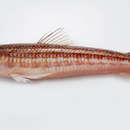Comprehensive Description
provided by Smithsonian Contributions to Zoology
Synodus fuscus Tanaka, 1917
Synodus fuscus Tanaka, 1917:38 [Japan].
MATERIAL EXAMINED.—FORMOSA STRAIT (2): CAS 28325 (1); NTU 103416 (1). JAPAN (18): CAS 23460 (1), FAKU 2261, 2262, 4762, 4764, 4770, 4774, 4781, 4782, 4788, 4811, 4813, 4816, 4817, 4820, 6558, 11824, 11827 (1 specimen per number).
DIAGNOSIS AND COMPARISONS.—A species of Synodus with the following combination of characters: dorsal-fin rays (branched and unbranched) 10–12 (usually 11); anal-fin rays 8–10 (usually 9); pored lateral-line scales 53-55 (usually 55); transverse scale rows 3.5/5; vertebrae 53-55 (usually 55); combined dorsal and anal procurrent rays 23–27; anterior palatine teeth longest and in a discrete group; peritoneal spots 9–10; posterior pelvic process wide.
Synodus fuscus is a rather nondescript species without decisive external characters that easily separate it from other Indo-West Pacific Synodus. The pectoral fin of S. fuscus is short (not reaching a line between the origins of the pelvic and dorsal fins). All other species except S. indicus, S. rubromarmoratus, S. kaianus, and S. sageneus have a pectoral fin reaching to or beyond this line. The base of the anal fin of S. sageneus is longer than the base of the dorsal fin, unlike that of S. fuscus. The vertebral count of S. kaianus is higher (58–63). The peritoneal spot count of S. rubromarmoratus is higher (12), and its anterior palatine teeth, unlike those of S. fuscus, are not longest or in a discrete group.
DESCRIPTION.—Dorsal-fin rays 10–12; anal-fin rays 8–10; pectoral-fin rays 12; pelvic-fin rays 8; procurrent rays 23–27, dorsal 12–15, anal 11–13; lateral line continuous, 53–55 pored scales; scale rows above lateral line from dorsal origin 3.5; scale rows below lateral line to anal origin 5; predorsal scales 15–18; rows of cheek scales 4–6; vertebrae 53–55; peritoneal spots 9–10.
Percentages of Standard Length: Mean (range): head length 27.7(23.8–30.6); snout length 6.6(5.6–7.5); upper jaw length 17.4(15.2–18.3); diameter of bony orbit 5.2(4.2–5.8); least width of bony interorbital 3.1(2.3–3.7); snout to dorsal origin 45.4(43.0–49.3); snout to adipose origin 87.9(84.8–93.6); snout to anal origin 80.7(76.3–87.2); snout to pelvic insertion 37.3(33.5–42.2); snout to pectoral insertion 27.4(25.2–29.8); first-dorsal-ray length 9.7(7.3–11.0); longest-dorsal-ray length 14.6(13.0–16.0); pectoral-fin length 11.9(10.9–12.9); pelvic-fin length 20.9(19.0–23.9); dorsal-fin base 12.7(11.0–14.3); anal-fin base 8.8(7.7–10.0); based on 9 specimens 112.6 to 221.7 mm SL.
Body fusiform, head somewhat depressed, caudal region a little compressed. Large cycloid scales on body, cheeks, and operculum, postoral portion of cheeks scaly. Snout sharply pointed, about as broad as long; the anterior nostril on each side bearing a long broad flap, widest near middle, extending well beyond margin of nares when depressed anteriorly. Interorbital space concave, occipital region bony. Palatine teeth in an elongate V-shaped pad, teeth pointing backwardly, those in front somewhat larger and in a discrete group. Lingual teeth well developed, those on free end of tongue largest and about 30 in number. Teeth caniniform, larger teeth with arrow-shaped tips. Pectoral fins not reaching a line from base of pelvic fins to origin of dorsal fin. Outer pelvic ray unbranched and short, fifth branched ray (sixth ray) longest. Posterior bony process of pelvic girdle narrow. Peritoneum pale.
COLOR PATTERN.—In preserved material dorsum somewhat darker than ventral surface, no trace of any pattern of pigment patches or spots, fins unmarked.
DISTRIBUTION AND HABITAT.—This species is known only from Formosa Strait and Japan. The only record indicating depth of capture is 60 m for the CAS Formosa Strait specimen.
- bibliographic citation
- Cressey, Roger F. 1981. "Revision of Indo- West Pacific lizardfishes of the genus Synodus (Pisces: Synodontidae)." Smithsonian Contributions to Zoology. 1-53. https://doi.org/10.5479/si.00810282.342
分布
provided by The Fish Database of Taiwan
分布於西北太平洋,包括日本及臺灣。臺灣分布於澎湖海域。
利用
provided by The Fish Database of Taiwan
偶為底拖網或延繩釣捕獲,可食用。
描述
provided by The Fish Database of Taiwan
體圓而瘦長,呈長圓柱形,尾柄兩側具稜脊。頭較短。吻圓,吻長明顯大於眼徑。眼中等大;脂性眼瞼發達。口裂大,上頜骨末端遠延伸至眼後方;頜骨具銳利之小齒;腭骨前方齒較後方齒長,明顯自成一叢。體被圓鱗,頭後背部、鰓蓋和頰部皆被鱗;側線鱗數55-56;側線上鱗數3.5(少數為4.5)。單一背鰭,具軟條10-12(通常為11);有脂鰭;臀鰭與脂鰭相對,具軟條8-9(通常為8);胸鰭短,末端不延伸至腹鰭起點與背鰭起點之連線;尾鰭叉形,上葉等長於下葉。體紅褐色,具多條不規則之深色斑紋;鰓蓋後緣不具黑斑。
棲地
provided by The Fish Database of Taiwan
主要棲息於淺海之砂泥底質的水域。屬肉食性,通常在砂地上停滯不動,身上的花紋是很好的偽裝,有時會將整個身體埋入砂中而只露出眼睛,等候獵物游經時,躍起吞食。
Synodus fuscus: Brief Summary
provided by wikipedia EN
Synodus fuscus is a species of lizardfish that lives mainly in the Northwest Pacific Ocean.
- license
- cc-by-sa-3.0
- copyright
- Wikipedia authors and editors

